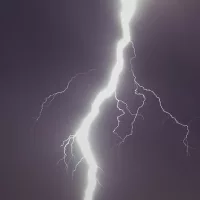
(Merritt Island, Fla.) — After several postponed launches, Axiom Space’s four private astronauts are finally on their way to the International Space Station (ISS).
The multinational crew lifted off successfully aboard a SpaceX Dragon launched by a Falcon 9 rocket from NASA’s Kennedy Space Center’s Launch Complex 39A in Florida early Wednesday at 2:31 a.m. EDT. The Dragon will dock with the ISS at approximately 7 a.m. EDT on Thursday.
In the final minutes before lift-off, SpaceX mission control wished the crew well, telling them to “Enjoy the ride and science the heck out of all your experiments.”
After the launch, it took about nine minutes for the spacecraft to reach orbit and begin its more than 28-hour journey to the ISS. SpaceX successfully returned the first-stage booster to Earth a little over seven minutes into the mission, with it landing nine miles from the launch site. The company plans to reuse the booster on a future mission.
For a time, the launch was in danger of being scrubbed when mission control had an issue with uploading wind conditions to the Dragon’s launch escape system. The data is crucial, as it enables the computer to accurately target an offshore splashdown location if the capsule needs to unexpectedly separate from the rocket in the event of an emergency.
The mission was delayed several times due to mechanical issues with the Falcon 9 booster and the ISS itself. NASA postponed the launch temporarily so it could evaluate repair work made to the Russian-built and maintained Zvezda Service Module.
For years, Roscosmos, the Russian space agency, has been attempting to seal air leaks in the module. In the days leading up to the Axiom launch, a “new pressure signature” was detected in an area with a long-standing leak. NASA said that the agency and Roscosmos have agreed on a technical solution to make the Axiom mission possible.
“NASA and Roscosmos have a long history of cooperation and collaboration on the International Space Station. This professional working relationship has allowed the agencies to arrive at a shared technical approach and now Axiom Mission 4 launch and docking will proceed,” said acting NASA Administrator Janet Petro in a statement.
The AX-4 mission marks another milestone for Axiom as it advances plans to build the world’s first commercial space station, Axiom Station, before NASA retires the ISS in 2030. Wednesday’s mission is the fourth team to visit the ISS since Axiom began partnering with NASA in 2022. The astronauts use their time aboard the station to conduct research, undergo training and participate in various scientific activities.
“The AX-4 crew represents the very best of international collaboration, dedication, and human potential. Over the past 10 months, these astronauts have trained with focus and determination, each of them exceeding the required thresholds to ensure mission safety, scientific rigor and operational excellence,” said Allen Flynt, Axiom Space’s chief of mission services, during a pre-launch press conference.
The four-person crew is traveling to the ISS aboard a newly built SpaceX Dragon spacecraft. SpaceX says this is the second time the Falcon 9 booster has been used and the maiden flight of a new Dragon capsule—named Grace—that includes multiple design upgrades.
“This is the first flight for this Dragon capsule, and it’s carrying an international crew—a perfect debut. We’ve upgraded storage, propulsion components and the seat lash design for improved reliability and reuse,” said William Gerstenmaier, SpaceX’s vice president of build and flight reliability.
Peggy Whitson, a former NASA astronaut and now director of human spaceflight at Axiom, is commanding the mission. Whitson, who has already spent 665 days in space across three long-duration NASA missions, also commanded Axiom’s AX-2 mission in 2023, adding another 10 days in orbit. She now holds the record for the most cumulative time spent in space by a woman.
“We’re thrilled to welcome Peggy Whitson back. This will be her fifth trip to space—three with NASA and now two with Axiom,” Dana Weigel, NASA’s manager of the International Space Station Program, said. “She’s made substantial contributions to ISS and now helps lay the foundation for future commercial missions.”
Joining Whitson on the AX-4 mission are astronauts from India, Poland and Hungary. This will be the first time that nationally-sponsored astronauts from those countries have visited the ISS. It has also been more than 40 years since those three countries sent someone into space.
Indian Air Force pilot and astronaut Shubhanshu Shukla, the mission’s pilot, will be the second person from India to go to space and the first since 1984. Polish engineer Sławosz Uznański-Wiśniewsk, a mission specialist and a European Space Agency project astronaut, will be the second person from his country to head to space and the first since 1978. And Tibor Kapu, a mechanical engineer and mission specialist, will be the second Hungarian astronaut to rocket into space. That country’s last space mission was 45 years ago.
“For India, Poland, and Hungary, this mission marks a return to human spaceflight after more than 40 years, and their first missions to the ISS. It’s a powerful reminder of what we can achieve when we work together across borders, disciplines, and cultures,” Flynt said.
The AX-4 mission will last up to 14 days, during which the crew will conduct about 60 scientific studies and experiments. The company said 31 countries have contributed to the research plan, and the projects will focus on biological, life and material sciences, as well as Earth observation. Axiom said that the work done at the station will help the company advance its goal of building Axiom Station, which would be the world’s first commercial space station.
To lay the foundation for its space station, Axiom plans to attach several of its commercial modules to the ISS while it’s still operational. When the ISS is decommissioned, those modules will detach from the station and become part of the privately run Axiom Station.
Unlike space tourism, which is operated independently of NASA and government support, the Axiom mission is part of NASA’s private astronaut mission program. This private-public partnership provides selected commercial space companies with access to the ISS and technical and logistical support from NASA.
“NASA’s framework for private astronaut missions gives industry responsibility for launch, free flight, and landing,” Weigel said.
“It’s an incredible time for spaceflight. These missions help train teams, build partnerships and shape the future of low Earth orbit,” she added.
SpaceX’s Dragon program has completed 52 launches and 17 human spaceflight missions while safely transporting 66 crew members from 17 countries. It has facilitated over 1,000 research experiments in microgravity and delivered 300,000 pounds of cargo to the ISS.
Copyright © 2025, ABC Audio. All rights reserved.















